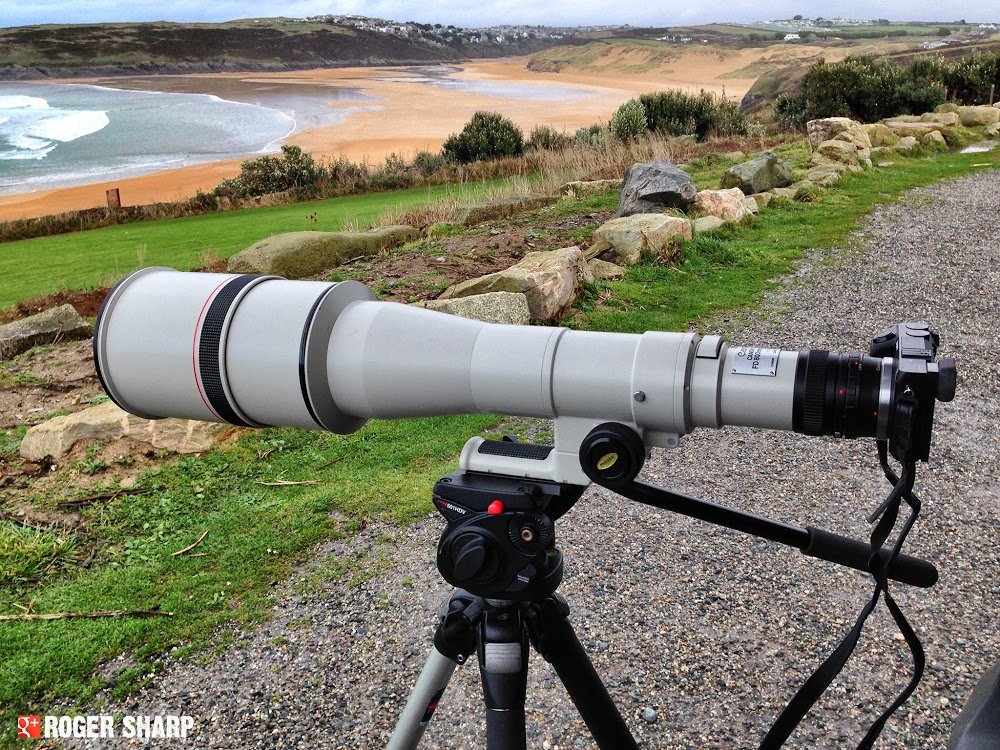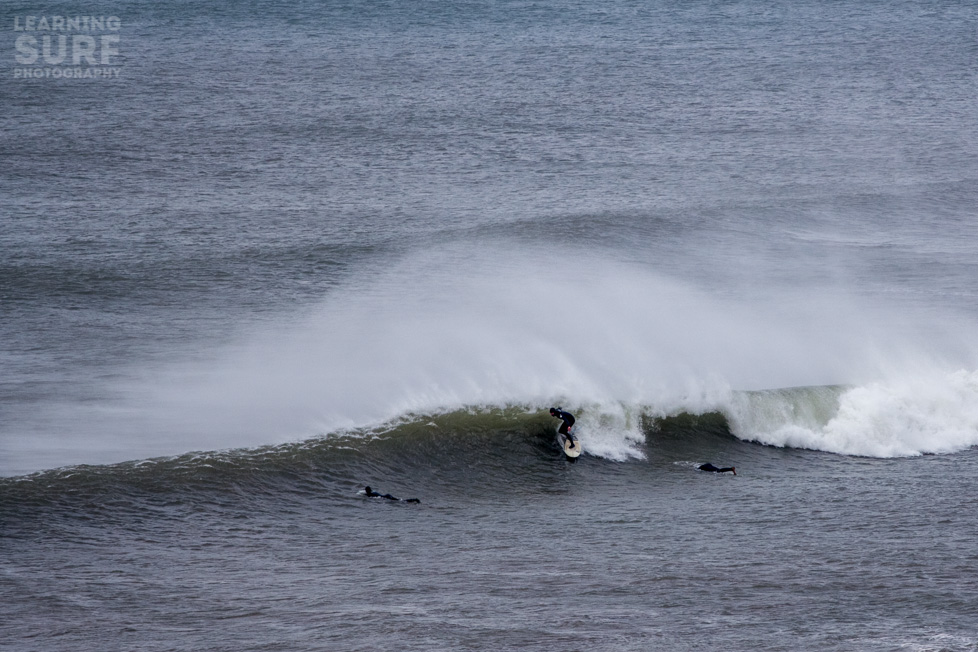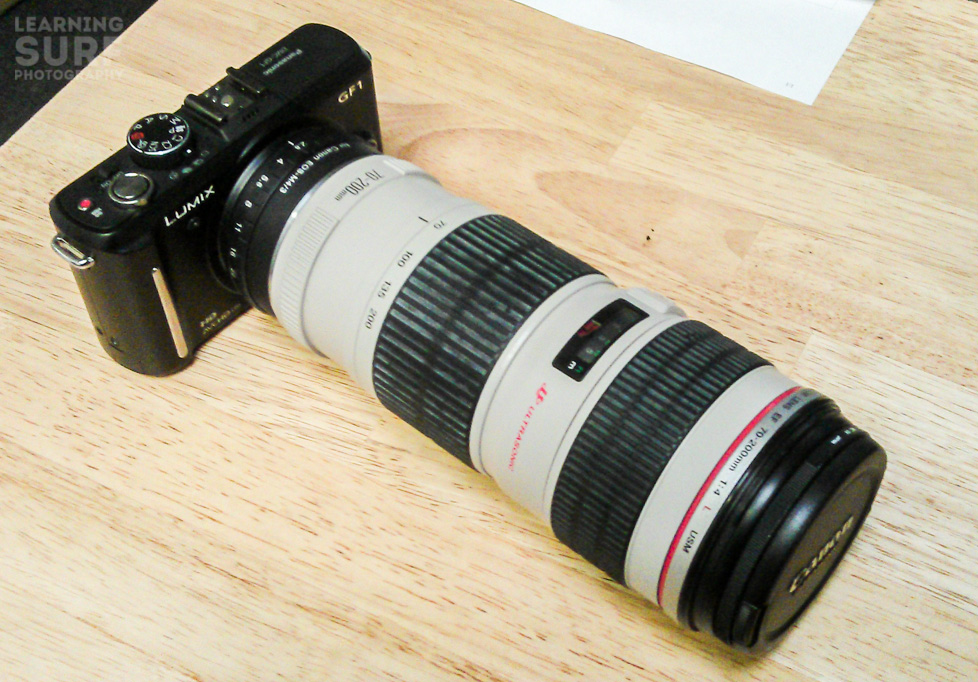I’ve got a Panasonic GF-1, it’s a mirrorless camera which uses the Micro Four thirds lens mount, I’ve got an adapter which allows me to use my Canon EF lenses on the camera, I don’t get auto focus, and aperture control is handled manually by the adapter, so whilst it’s fun to use, especially with my Tokina 10-17mm fisheye, it’s not ideal for shooting from the land.
Roger Sharp has a Sony NEX 7, it’s got an APS-C sized sensor, bigger than my GF-1’s, the same size as my Canon 60D and the Canon 7D that he uses to shoot surf photo’s.
On his Google+ page he’s recently put up some samples shot using an old Canon FD mount 800mm lens, check out the link for more:
https://plus.google.com/109140495815120859352/posts/8tBrUsgy2a3

Manually focusing such a long lens and keeping your framing right sounds like hard work:
I’ve got to get my manual focus skills back up for shooting surfing but it sure as hell makes it a lot more fun than just hitting the back AF button and knowing for sure the shot will be in focus. It’s nice to be using a skill again.
Personally, at my level, knowing for sure the shot will be in focus sounds pretty good, if you’re not familiar with using the back AF button, it basically means taking the focus control away from the shutter release button, allowing you to stop focusing when something else gets in the way then resume without stopping taking photo’s, and if you’re just starting out it’s a skill in itself.
Following on from Tim Nunns discussion of big lenses, where the conclusion was that lengths beyond 300mm (with a 1.4x adapter, on a cropped sensor body) were not strictly necessary, it sounds like this set-up, with a 35mm equivalent focal length of 1200mm, is going to be used for a few very specific situations where very long reach is needed, exactly the type of situations Roger Sharp is going to be in, covering competitions and other sessions where the surfers are guaranteed to be surfing at a spot with a long paddle out.

For a pro who needs the 1200mm, has the experience with this kind of kit, and has a spare camera body that can take advantage of old glass with an adapter, this is a fantastic way to breathe new life into older, cheaper, lenses and get some quality surf shots, but is it something your average person learning surf photography should consider?
Should I do this?
If you’re reading this site the chances are you’re just getting into surf photography and you probably shouldn’t go to the trouble of trying this out, I’ve tinkered with the Canon 70-200mm on my GF-1, but I haven’t tried to shoot anything properly with the adapter at anything longer than 50mm.

I had a look at prices for the 800mm FD, the only example I can find currently on eBay is up for around £1200, and it’s shipped in from Tokyo, I know this is a fraction of the cost of buying a Canon EF 800mm, but it still puts it in the same ball park as the Canon EF 400mm f5.6, or the Canon EF 100-400mm f4-f5.6.
Plus you’ll want a camera that will do it justice, the Sony NEX 7 is an awesome camera but it’s not really up to being the only camera in your kit bag if you want to take photo’s in the water (no remote shutter release and lack of support from housing manufacturers is an issue), it costs about the same as a Canon 60D or second hand Canon 7D in good condition.
So what should I do?
The best option if you already have a capable camera body, and you are going to be in one of the rare situations that warrants having this kind of reach, is to rent a lens.
Lens Pimp in the UK and Borrow Lenses in the US both offer the 800mm Canon EF lens, and equivalents for Nikon shooters, for around £220 or $340 for 3 days of use, you’ll also need to buy or rent a decent tripod if you don’t have one already.
This sounds expensive, but this kind of situation only comes about every so often for average photographers, and it’s not worth your time learning manual focus techniques that you wont use anywhere else, so the modern lens pays for itself in this situation by making it easier to get the shots you need.
P.S
I do love the idea of using old gear on modern cameras, and cheap lenses and adapters can be really useful for video, where the manual control is pretty much necessary anyway, here’s an old post on one of my other sites about using old lenses on a more modern camera: rskdiy.com/post/10948301136/cheap-dslr-lenses
Leave a Reply